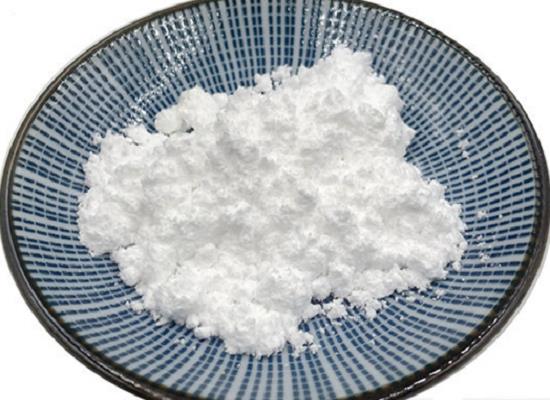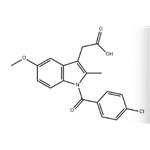Indomethacin: Pharmacokinetics and Mechanism of Action
May 29,2024
General Description
Indomethacin, a nonsteroidal anti-inflammatory drug (NSAID), exhibits linear pharmacokinetics with rapid and nearly complete absorption from the gastrointestinal tract. Peak plasma concentrations, typically reached within 0.9-1.5 hours, increase with dose and are dose-proportional. Age-related changes impact renal excretion, while food and antacids can affect absorption to some extent. Indomethacin's high plasma protein binding and presence in synovial fluid indicate its distribution characteristics. Mechanistically, indomethacin's unique actions in conditions like trigeminal autonomic cephalalgias involve modulation of intracranial pressure, cerebral blood flow, and vasoconstrictive effects beyond COX enzyme inhibition. Its potential in managing conditions such as elevated intracranial pressure highlights its distinct therapeutic value.

Figure 1. Indomethacin
Pharmacokinetics
Indomethacin, a nonsteroidal anti-inflammatory drug, follows linear pharmacokinetics characterized by dose-proportional changes in plasma concentration and area under the curve (AUC). The absorption of indomethacin is rapid from the gastrointestinal tract, with almost 100% bioavailability after oral administration. Peak plasma concentrations typically occur between 0.9-1.5 hours in fasting subjects. Despite considerable inter-subject variability, peak plasma concentrations increase with dose and are dose-proportional. Steady-state plasma concentrations range from 0.39 to 0.63 μg/mL after multiple 25 mg doses per day. A therapeutic range of 0.5–3 μg/mL has been suggested for an anti-inflammatory effect. Indomethacin exists in extended release formulations containing 75 mg of pelletized drug, with a portion immediately released and the rest gradually released over time to provide sustained plasma levels and mitigate gastrointestinal side effects. The absorption of indomethacin is affected by food, with a decrease in rate when taken with a high-carbohydrate diet. Antacids containing aluminum and magnesium hydroxides may slightly decrease and delay peak plasma concentrations but are not considered clinically significant. Age-related changes primarily impact renal excretion, with biotransformation being the main elimination route. Indomethacin is highly bound to plasma proteins and tissues, with peak concentrations in synovial fluid usually occurring around 1–1.5 hours post-plasma peak. NSAIDs, including indomethacin, tend to accumulate more in inflamed joints due to differences in pH levels between inflamed and non-inflamed tissues. Overall, the pharmacokinetics of indomethacin demonstrate its predictable dose-proportional behavior, rapid absorption, and potential for sustained release to maintain therapeutic plasma levels. Understanding these factors is crucial for optimizing dosing regimens and ensuring effective treatment outcomes in various clinical settings. 1
Mechanism of Action
Indomethacin is a nonsteroidal anti-inflammatory drug that exhibits a unique mechanism of action in the treatment of certain headache disorders, specifically the trigeminal autonomic cephalalgias (TACs) such as paroxysmal hemicrania (PH) and hemicrania continua (HC). While the precise mechanisms are still being elucidated and primarily studied in animal models, indomethacin has shown distinct bioactivity compared to other NSAIDs. One key aspect of indomethacin's mechanism of action is its modulation of intracranial pressure and volume activity. Studies have demonstrated that indomethacin can reduce basal cerebral blood flow and blunt responses to hypercapnia. This suggests that indomethacin may act as a potent vasoconstrictor, influencing cerebral blood flow and cerebrovascular tone through mechanisms beyond simply inhibiting the COX enzyme. Additionally, indomethacin has been found to affect cerebral vasoconstriction without significantly impacting cerebral metabolic rate or responses to arterial hypoxia. In conditions such as liver failure, intracerebral hematoma, and idiopathic intracranial hypertension, indomethacin has shown promising results in reducing intracranial pressure and improving cerebral perfusion pressure. In clinical studies involving severely brain-injured patients, indomethacin administration led to a rapid decrease in intracranial pressure and an increase in cerebral perfusion pressure, indicating its potential therapeutic value in managing elevated intracranial pressure. Furthermore, human studies have shown that indomethacin can decrease peak flow velocity driven by cortical activation, suggesting its influence on cerebrovascular function beyond COX inhibition. Overall, the unique mechanisms of action exhibited by indomethacin, including its effects on cerebral blood flow regulation, vasoconstriction, and cerebrovascular tone modulation, distinguish it from other NSAIDs and make it a valuable therapeutic option for certain types of headaches like PH and HC. Further research is needed to fully understand the intricacies of indomethacin's actions in these conditions. 2
Reference
1. Lucas S. The Pharmacology of Indomethacin. Headache. 2016; 56(2): 436-446.
2. Summ O, Evers S. Mechanism of action of indomethacin in indomethacin-responsive headaches. Curr Pain Headache Rep. 2013; 17(4): 327.
- Related articles
- Related Qustion
- Pharmacological effects of indomethacin Mar 28, 2022
Indomethacin is suitable for antipyretic and inflammatory pain relief
Huperzine A, a compound derived from the Chinese club moss Huperzia serrata, its significant impact on neuroprotection and cognition enhancement.....
May 29,2024APINorfloxacin, an antibiotic for UTIs, peaks in serum 1-2 hours post oral intake. Renally eliminated, it exhibits mild adverse effects and favorable outcomes in studies.....
May 29,2024APIIndometacin
53-86-1You may like
- Indometacin
-

- $0.00 / 25kg
- 2024-07-15
- CAS:53-86-1
- Min. Order: 25kg
- Purity: 99.0%
- Supply Ability: 10tons
- Indometacin
-

- $29.00 / 1g
- 2024-07-12
- CAS:53-86-1
- Min. Order: 1g
- Purity: 99%
- Supply Ability: 8000g
- Indometacin
-

- $0.00 / 1Kg/Bag
- 2024-07-10
- CAS:53-86-1
- Min. Order: 1Kg/Bag
- Purity: 0.99
- Supply Ability: 20 tons




